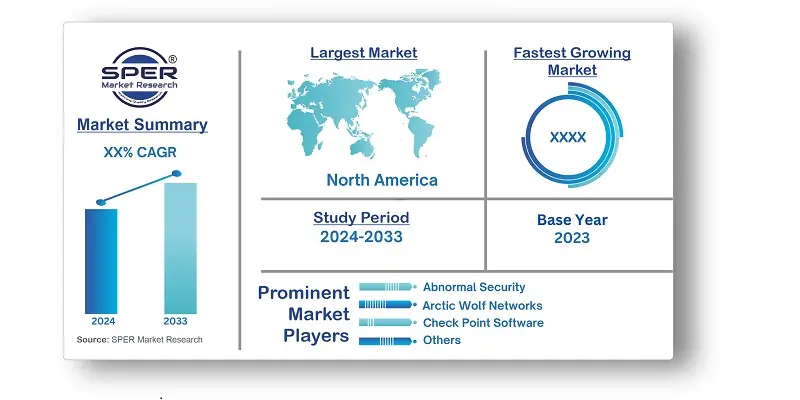
US Healthcare Cybersecurity Market Growth, Size, Trends, Demand, Revenue and Future Outlook
US Healthcare Cybersecurity Market Size- By Threat Type, By Offering, By Security Type, By End User- Regional Outlook, Competitive Strategies and Segment Forecast to 2033
| Published: Apr-2024 | Report ID: IACT2471 | Pages: 1 - 102 | Formats*: |
| Category : Information & Communications Technology | |||


| Report Metric | Details |
| Market size available for years | 2020-2033 |
| Base year considered | 2023 |
| Forecast period | 2024-2033 |
| Segments covered | By Threat Type, By Offering, By Security Type, By End User |
| Regions covered | East Region, North Region, South Region, West Region |
| Companies Covered | Abnormal Security, Arctic Wolf Networks, Check Point Software, Cloudflare, CrowdStrike, Health Linkages, Iatric Systems, LME Services, LogRhythm, McAfee, Palo Alto Networks, Virta Labs, Others |
- Healthcare Insurers
- Healthcare IT Professionals
- Healthcare Technology Vendors
- Medical Device Manufacturers
- Patients and Healthcare Consumers
- Third-Party Service Providers
- Others
| By Threat Type: |
|
| By Offering: |
|
| By Security Type: |
|
| By End User: |
|
- US Healthcare Cybersecurity Market Size (FY'2024-FY'2033)
- Overview of US Healthcare Cybersecurity Market
- Segmentation of US Healthcare Cybersecurity Market By Threat Type (APT, DDOS, Malware, Phishing, Ransomware, Other Threat Types)
- Segmentation of US Healthcare Cybersecurity Market By Offering (Services, Solutions)
- Segmentation of US Healthcare Cybersecurity Market By Security Type (Application Security, Cloud Security, Endpoint and loT Security, Network Security)
- Segmentation of US Healthcare Cybersecurity Market By End User (Government Healthcare Agencies, Health Insurance Providers and Payers, Hospitals and Healthcare Facilities, Medical Device Manufacturers, Pharmaceuticals and Biotechnology, Telehealth and Digital Health Providers)
- Statistical Snap of US Healthcare Cybersecurity Market
- Expansion Analysis of US Healthcare Cybersecurity Market
- Problems and Obstacles in US Healthcare Cybersecurity Market
- Competitive Landscape in the US Healthcare Cybersecurity Market
- Impact of COVID-19 and Demonetization on US Healthcare Cybersecurity Market
- Details on Current Investment in US Healthcare Cybersecurity Market
- Competitive Analysis of US Healthcare Cybersecurity Market
- Prominent Players in the US Healthcare Cybersecurity Market
- SWOT Analysis of US Healthcare Cybersecurity Market
- US Healthcare Cybersecurity Market Future Outlook and Projections (FY'2024-FY'2033)
- Recommendations from Analyst
1.1. Scope of the report1.2. Market segment analysis
2.1. Research data source2.1.1. Secondary Data2.1.2. Primary Data2.1.3. SPER’s internal database2.1.4. Premium insight from KOL’s2.2. Market size estimation2.2.1. Top-down and Bottom-up approach2.3. Data triangulation
4.1. Driver, Restraint, Opportunity and Challenges analysis4.1.1. Drivers4.1.2. Restraints4.1.3. Opportunities4.1.4. Challenges4.2. COVID-19 Impacts of the US Healthcare Cybersecurity Market
5.1. SWOT Analysis5.1.1. Strengths5.1.2. Weaknesses5.1.3. Opportunities5.1.4. Threats5.2. PESTEL Analysis5.2.1. Political Landscape5.2.2. Economic Landscape5.2.3. Social Landscape5.2.4. Technological Landscape5.2.5. Environmental Landscape5.2.6. Legal Landscape5.3. PORTER’s Five Forces5.3.1. Bargaining power of suppliers5.3.2. Bargaining power of buyers5.3.3. Threat of Substitute5.3.4. Threat of new entrant5.3.5. Competitive rivalry5.4. Heat Map Analysis
6.1. US Healthcare Cybersecurity Market Manufacturing Base Distribution, Sales Area, Product Type6.2. Mergers & Acquisitions, Partnerships, Product Launch, and Collaboration in US Healthcare Cybersecurity Market
7.1. US Healthcare Cybersecurity Market Value Share and Forecast, By Threat Type, 2024-20337.2. APT7.3. DDOS7.4. Malware7.5. Phishing7.6. Ransomware7.7. Other Threat Types
8.1. US Healthcare Cybersecurity Market Value Share and Forecast, By Offering, 2024-20338.2. Services8.2.1. Managed Services8.2.2. Professional Services8.3. Solutions8.3.1. Antivirus/Antimalware8.3.2. Compliance and Policy Management8.3.3. Encryption and Tokenization8.3.4. Firewall8.3.5. IAM8.3.6. Log Management and SIEM8.3.7. Patch Management8.3.8. Other Solution Types
9.1. US Healthcare Cybersecurity Market Value Share and Forecast, By Security Type, 2024-20339.2. Application Security9.3. Cloud Security9.4. Endpoint and loT Security9.5. Network Security
10.1. US Healthcare Cybersecurity Market Value Share and Forecast, By End User, 2024-203310.2. Government Healthcare Agencies10.3. Health Insurance Providers and Payers10.4. Hospitals and Healthcare Facilities10.5. Medical Device Manufacturers10.6. Pharmaceuticals and Biotechnology10.7. Telehealth and Digital Health Providers
11.1. US Healthcare Cybersecurity Market Size and Market Share
12.1. US Healthcare Cybersecurity Market Size and Market Share By Threat Type (2020-2026)12.2. US Healthcare Cybersecurity Market Size and Market Share By Threat Type (2027-2033)
13.1. US Healthcare Cybersecurity Market Size and Market Share By Offering (2020-2026)13.2. US Healthcare Cybersecurity Market Size and Market Share By Offering (2027-2033)
14.1. US Healthcare Cybersecurity Market Size and Market Share By Security Type (2020-2026)14.2. US Healthcare Cybersecurity Market Size and Market Share By Security Type (2027-2033)
15.1. US Healthcare Cybersecurity Market Size and Market Share By End User (2020-2026)15.2. US Healthcare Cybersecurity Market Size and Market Share By End User (2027-2033)
16.1. US Healthcare Cybersecurity Market Size and Market Share By Region (2020-2026)16.2. US Healthcare Cybersecurity Market Size and Market Share By Region (2027-2033)16.3. East Region16.4. North Region16.5. South Region16.6. West Region
17.1. Abnormal Security17.1.1. Company details17.1.2. Financial outlook17.1.3. Product summary17.1.4. Recent developments17.2. Arctic Wolf Networks17.2.1. Company details17.2.2. Financial outlook17.2.3. Product summary17.2.4. Recent developments17.3. Check Point Software17.3.1. Company details17.3.2. Financial outlook17.3.3. Product summary17.3.4. Recent developments17.4. Cloudflare17.4.1. Company details17.4.2. Financial outlook17.4.3. Product summary17.4.4. Recent developments17.5. CrowdStrike17.5.1. Company details17.5.2. Financial outlook17.5.3. Product summary17.5.4. Recent developments17.6. Health Linkages17.6.1. Company details17.6.2. Financial outlook17.6.3. Product summary17.6.4. Recent developments17.7. Iatric Systems17.7.1. Company details17.7.2. Financial outlook17.7.3. Product summary17.7.4. Recent developments17.8. LME Services17.8.1. Company details17.8.2. Financial outlook17.8.3. Product summary17.8.4. Recent developments17.9. LogRhythm17.9.1. Company details17.9.2. Financial outlook17.9.3. Product summary17.9.4. Recent developments17.10. McAfee17.10.1. Company details17.10.2. Financial outlook17.10.3. Product summary17.10.4. Recent developments17.11. Palo Alto Networks17.11.1. Company details17.11.2. Financial outlook17.11.3. Product summary17.11.4. Recent developments17.12. Virta Labs17.12.1. Company details17.12.2. Financial outlook17.12.3. Product summary17.12.4. Recent developments17.13. Others
SPER Market Research’s methodology uses great emphasis on primary research to ensure that the market intelligence insights are up to date, reliable and accurate. Primary interviews are done with players involved in each phase of a supply chain to analyze the market forecasting. The secondary research method is used to help you fully understand how the future markets and the spending patterns look likes.
The report is based on in-depth qualitative and quantitative analysis of the Product Market. The quantitative analysis involves the application of various projection and sampling techniques. The qualitative analysis involves primary interviews, surveys, and vendor briefings. The data gathered as a result of these processes are validated through experts opinion. Our research methodology entails an ideal mixture of primary and secondary initiatives.



Frequently Asked Questions About This Report
PLACE AN ORDER
Year End Discount
Sample Report
Pre-Purchase Inquiry
NEED CUSTOMIZATION?
Request CustomizationCALL OR EMAIL US
100% Secure Payment






Related Reports
Our Global Clients
Our data-driven insights have influenced the strategy of 200+ reputed companies across the globe.




















